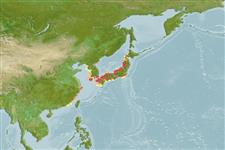Common names from other countries
Issue
Acanthogobius stigmothonus (Richardson, 1845) is considered as valid (from the South China Sea and Gulf of Tonkin) in Shibukawa & Iwata, 2013 (Ref. 93271).
Environment: milieu / climate zone / depth range / distribution range
Ecologie
marien; zoet water; brak water demersaal; amfidroom (Ref. 51243); diepte 1 - 6 m (Ref. 96339). Temperate; 52°N - 23°N, 116°E - 143°E
Northwest Pacific: Russian Far East (from Amur to Peter the Great Gulf), Korean Peninsula, Bohai Sea, Yellow Sea and East China Sea of China, and Hokkaido to Kyushu of Japan.
Lengte bij maturiteit / Grootte / Gewicht / Leeftijd
Maturity: Lm 27.0 range ? - ? cm
Max length : 30.0 cm TL mannelijk / geslacht onbekend; (Ref. 2850); common length : 14.5 cm TL mannelijk / geslacht onbekend; (Ref. 12193)
Inhabits muddy and sandy bottoms along the shore of bays and estuaries, sometimes ascends rivers. Intertidal to at least 6.5 m (Ref. 96339). Oviparous, spawn in winter to early spring (Ref. 205). Eggs are deposited in Y-shaped nests (Ref. 205). Used in Chinese medicine (Ref. 12166).
Eggs are deposited near the base of the Y-shaped nest (Ref. 51058).
Shibukawa, K. and A. Iwata, 2013. Review of the East Asian gobiid genus Chaeturichthhys (Teleostei: Perciformes: Gobioidei), with description of a new species. Bull. Nat. Mus. Nat. Sci. Ser. A., Suppl. 7:53-66. (Ref. 93271)
Status op de Rode Lijst van het IUCN (Ref. 130435)
CITES (Ref. 128078)
Not Evaluated
Gevaar voor de mens
Harmless
Gebruik door de mens
Visserij: commercieel; Aquarium: Publieke aquaria
Tools
Speciale rapporten
Download XML
Internetbronnen
Estimates based on models
Preferred temperature (Ref.
115969): 12 - 21.6, mean 17.9 (based on 189 cells).
Fylogenetische diversiteitsindex (Ref.
82804): PD
50 = 0.5156 [Uniqueness, from 0.5 = low to 2.0 = high].
Bayesian length-weight: a=0.00692 (0.00373 - 0.01284), b=3.01 (2.85 - 3.17), in cm Total Length, based on LWR estimates for this species & (Sub)family-body (Ref.
93245).
Trofisch niveau (Ref.
69278): 3.4 ±0.3 se; based on diet studies.
Weerstandsvermogen (Ref.
120179): Gemiddeld, minimale populatieverdubbelingstijd 1,4-4,4 jaar (Preliminary K or Fecundity.).
Fishing Vulnerability (Ref.
59153): Low to moderate vulnerability (33 of 100).
